|
San Diego
walking tours home page |
Balboa Park
walking tours home page |
Balboa Park:
Sunday Afternoon in the Park
a walking tour by Carol Mendel
Distance: Almost a mile. Time: One and a half hours.
Terms of Use
This self-guided walking tour is best on a Sunday afternoon, although it can be taken anytime. Many of the buildings on the walk date from the California-Pacific International Exposition of 1935-1936. (More information about the 1935-36 expo...)
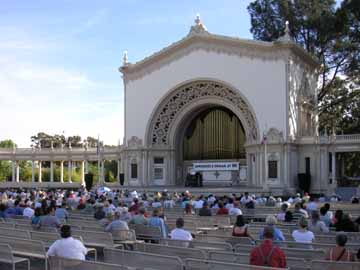
|
The concerts last an hour, but if it is summertime, which in this case means late March through October, you will want to leave the concert early in order to see some of the folk dancing at the House of Pacific Relations.
Leave the organ pavilion from the right side, cross the main road, and follow the narrow road that bends around to the left.
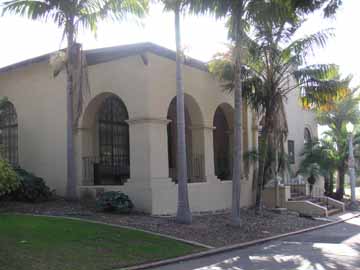
|
Just as the El Prado walk contains a few buildings from the 1935-1936 expo, this walk contains a few buildings from the 1915-1916 exposition. (More about the 1915-1916 expo...) This is one of them, although its low, simple design has none of the elaborate ornamentation of the Spanish Colonial architecture along El Prado. During the first exposition it contained the exhibits from Utah; during the second it was used to plan that fair's extensive floral exhibits. Now it is used by an organization called the House of Pacific Relations, whose main buildings you will come to in a few minutes.
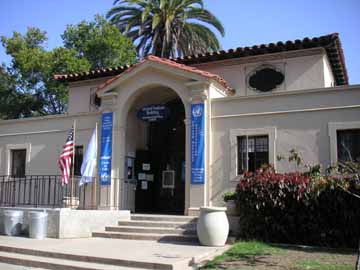
|
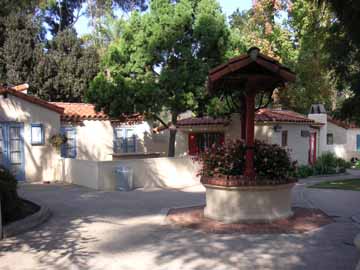
|
For four hours every Sunday afternoon, each cottage holds an Open House. During these hours you can visit the houses, have refreshments, and meet people who have come to San Diego from many parts of the world. The houses are furnished with native decorations, pictures, crafts and, occasionally, magazines and music. Between March and October, the countries take turns presenting native music and dancing on the lawn, all in appropriate folk costumes, in programs lasting from 30 minutes to an hour. Check the organization's website for the lawn program schedule.
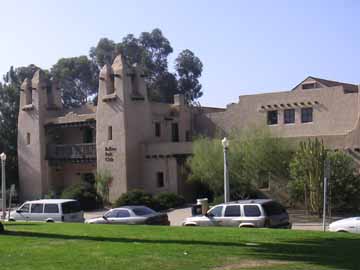
|
Inside the building, the theme of education is portrayed in the large main room. On the far wall, a W.P.A. artist painted an enormous mural. In the top center stands a figure of youth, surrounded by representations of progress through the ages. Today the Balboa Park Club hosts dance groups, receptions, banquets, and parties.
Next door to the Balboa Park Club is the Palisades Building, built for the second fair. Like its more elderly neighbor, the Palisades Building features pueblo-style architecture. During the fair it housed the Woman's Palace. Now it houses Recital Hall and the Marie Hitchcock Puppet Theater, which stages puppet shows for children.
Next you will come to the Conference Building, a 20th Century version of ancient Mayan massiveness and styling. It is now the home of the San Diego Automotive Museum, and displays a core collection of vintage vehicles, plus rotating exhibits.
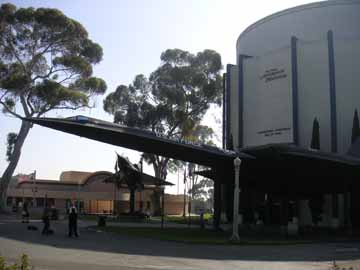
|
Now the building houses the San Diego Air & Space Museum. Standing sentinel in front of the museum is an A-12 Blackbird, perhaps the most daunting reconnaissance plane ever flown. This titanium marvel was capable of Mach 3 flight at altitudes above 85,000 feet.
The Air and Space Museum contains a large collection of flying machines beginning with the first airplanes. A highlight of the collection is the only reproduction of Charles Lindbergh's Spirit of Saint Louis, which was designed and built by Ryan Aircraft of San Diego. The original plane is in the Smithsonian Institution in Washington, D.C. The Hall of Fame contains pictures and memorabilia of outstanding aerospace pioneers.
When you have finished your visit to the museum, continue your walk.The Starlight Bowl slopes down the canyon on the east side of the Aerospace Museum. Here Ford Motor Company presented free symphony orchestra concerts and other entertainment during the 1935 exposition.
On the other side of the Starlight Bowl the exposition erected a Palace of Electricity and Varied Industries. Be sure to notice the appropriate decorative pavement at the main entrance. Like the Conference Building it faces across the plaza, the concrete and stucco building is supposed to reflect Mayan architecture. Today it finds regular use as a gymnasium. Take a peek inside to see what is going on, and if you like what you see sit down and watch awhile on the spectators' bleachers.

|
During the fair the building housed U.S. government exhibits. As one of its "attractions," the government offered to take your fingerprints. For several recent decades the building was home to the San Diego Hall of Champions, a sports museum, but that museum closed in 2017. In 2021 the Federal Building will welcome a new tenant: the Comic-Con Museum.
Until the new museum opens, pass by the Federal Building and follow the road that leads back to the Organ Pavilion. In a few minutes you will be back where your walk began.
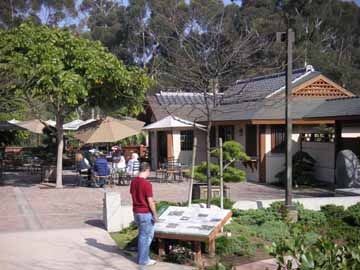
|
Return to top.
|
Enjoy this walking tour?
Check out the others in this series Balboa Park Cabrillo National Monument Downtown San Diego The Embarcadero La Jolla La Playa Mission Bay Park Mission Beach Old Town Shelter Island Sunset Cliffs |
Enjoy full-color illustrated maps? Check out the ones below. Some can be purchased as laminated maps, some as folded maps, some as wooden trays, and some as all three. San Diego Los Angeles Palm Springs Santa Barbara San Francisco Bay Area Las Vegas Salt Lake City Oregon Washington DC |